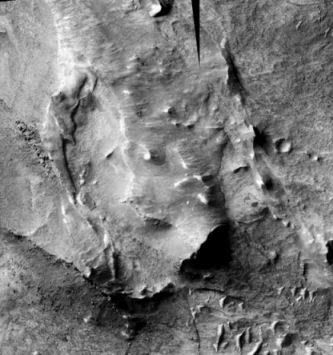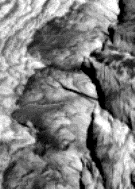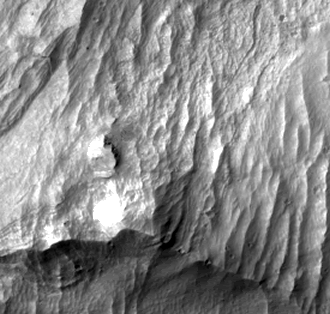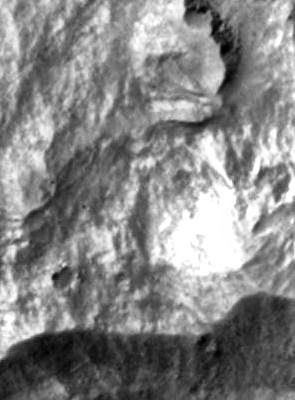- Thank you received: 0
Mro--First Looks
- neilderosa
-
- Offline
- Platinum Member
-

Less
More
18 years 5 months ago #17666
by neilderosa
Replied by neilderosa on topic Reply from Neil DeRosa
<blockquote id="quote"><font size="2" face="Verdana, Arial, Helvetica" id="quote">quote:<hr height="1" noshade id="quote">Yes, I don't think this issue will ever be settled on the basis of art.[rd]<hr height="1" noshade id="quote"></blockquote id="quote"></font id="quote">
I wouldn't give up just yet. Once the experts start looking at the evidence seriously it may be a whole different story. A good analogy would be the archeological record of 2 million years of stone implement making right here on earth. There is a fine art to just being able to tell a "pebble" from a "hand ax." But gradually a science developed and many patterns were recognized, along with thousands of recognized exhibits that the experts now have no doubt are "artificial." But to the layman they still look like "pebbles."
I wouldn't give up just yet. Once the experts start looking at the evidence seriously it may be a whole different story. A good analogy would be the archeological record of 2 million years of stone implement making right here on earth. There is a fine art to just being able to tell a "pebble" from a "hand ax." But gradually a science developed and many patterns were recognized, along with thousands of recognized exhibits that the experts now have no doubt are "artificial." But to the layman they still look like "pebbles."
Please Log in or Create an account to join the conversation.
- neilderosa
-
- Offline
- Platinum Member
-

Less
More
- Thank you received: 0
18 years 5 months ago #17667
by neilderosa
Replied by neilderosa on topic Reply from Neil DeRosa
<blockquote id="quote"><font size="2" face="Verdana, Arial, Helvetica" id="quote">quote:<hr height="1" noshade id="quote">Once the experts start looking at the evidence seriously it may be a whole different story. A good analogy would be the archeological record of 2 million years of stone implement making right here on earth. There is a fine art to just being able to tell a "pebble" from a "hand ax." But gradually a science developed and many patterns were recognized, along with thousands of recognized exhibits that the experts now have no doubt are "artificial." But to the layman they still look like "pebbles."
<hr height="1" noshade id="quote"></blockquote id="quote"></font id="quote">
When I said "experts" I really meant "specialists." Anthropologists well grounded in geology were able to determine what shapes could naturally form by the processes that were normally evident in the locations they searched. They gradually came to "know" when a rock shape could not be natural, even though it might look that way to the layman.
I have no doubt that the same skills exist or will be developed concerning Mars artifacts. Though I myself don't posses them; I'm going on intuition and certain deductive models mentioned many times.
Here's an example of what I mean. I post again the large face found in the Coprates Labes image from TRA0008491675.
It seems obvious to me, for example that if the specialist looks at the "lips" in this image, they should be able to tell the processes that made them. Of course, before they will be able to consider such things they need to be open to the possibility of the artificiality hypothesis. And that may not come until a "smoking gun" is discovered and publicized, such as some artificial material, colored blue, composing a detailed eye on the Cydonia face, or a door to its inner chambers, or some such evidence.
Likewise, here's type of a "long nose" face seen many places in the MOC images, but seen here in detail. It should be clear to a specialist whether this rock formation was chipped away to achieve its peculiar shape, or whether in could occur naturally. But first they would have to be open to the possibility. Here's TRA0008231720 face 1 (from Ius Chasma).
Image 1720 is resolved at 25 cm/p, and has 200 p/inch at 100%. At 100%, the long nose face is 3" wide = 600 pixels = 150 meters wide (actual).
Here's a reduced context of long nose from same image.
And for comparison, here's a previously posted image from the MOC. These faces, cropped from E1103633, are around the same size as long nose, possibly a little larger (200 - 250 meters wide). Their resolution is 4.52 m/p, which makes long nose (at .25 cm/p) 18 times higher resolution.
Neil
<hr height="1" noshade id="quote"></blockquote id="quote"></font id="quote">
When I said "experts" I really meant "specialists." Anthropologists well grounded in geology were able to determine what shapes could naturally form by the processes that were normally evident in the locations they searched. They gradually came to "know" when a rock shape could not be natural, even though it might look that way to the layman.
I have no doubt that the same skills exist or will be developed concerning Mars artifacts. Though I myself don't posses them; I'm going on intuition and certain deductive models mentioned many times.
Here's an example of what I mean. I post again the large face found in the Coprates Labes image from TRA0008491675.
It seems obvious to me, for example that if the specialist looks at the "lips" in this image, they should be able to tell the processes that made them. Of course, before they will be able to consider such things they need to be open to the possibility of the artificiality hypothesis. And that may not come until a "smoking gun" is discovered and publicized, such as some artificial material, colored blue, composing a detailed eye on the Cydonia face, or a door to its inner chambers, or some such evidence.
Likewise, here's type of a "long nose" face seen many places in the MOC images, but seen here in detail. It should be clear to a specialist whether this rock formation was chipped away to achieve its peculiar shape, or whether in could occur naturally. But first they would have to be open to the possibility. Here's TRA0008231720 face 1 (from Ius Chasma).
Image 1720 is resolved at 25 cm/p, and has 200 p/inch at 100%. At 100%, the long nose face is 3" wide = 600 pixels = 150 meters wide (actual).
Here's a reduced context of long nose from same image.
And for comparison, here's a previously posted image from the MOC. These faces, cropped from E1103633, are around the same size as long nose, possibly a little larger (200 - 250 meters wide). Their resolution is 4.52 m/p, which makes long nose (at .25 cm/p) 18 times higher resolution.
Neil
Please Log in or Create an account to join the conversation.
- neilderosa
-
- Offline
- Platinum Member
-

Less
More
- Thank you received: 0
18 years 5 months ago #17670
by neilderosa
Replied by neilderosa on topic Reply from Neil DeRosa
Another analogy from paleoanthropology
I should apologize to Trinket for monopolizing his thread in posting and discussing more of these newly discovered faces, but because the HIRISE project is just beginning, there isn’t much to see—yet. If and when this story develops, I’ll move to a topic of my own. Or maybe someone more qualified than me will take it up.
Another little foray into the history of science, this one from Ian Tattersall’s <i>The Fossil Trail</i>.
"The idea of prehistoric art took some time to be absorbed by the establishment…[but] Cave art from the Paleolithic took much longer to be accepted. The first such discovery was…the spectacular painted ceiling of the cave of Altamira, in northern Spain [by de Sautuola’s young daughter]…the now-famous polychrome representations of bison, horses, and other large mammals…Initial reaction to this remarkable find was favorable, but in academic circles a reaction soon set in. Supporters of de Sautuola were soon in a tiny minority. It was not until corroborating finds began to be made…near the end of the century that opinion turned in the now-dead de Sautuola’s favor and the cave art of the upper Paleolithic was finally accepted." (28)
The players have changed but the story remains remarkable unchanged. Indeed, with the vast sums of money involved today, one could reasonably say the situation has gotten worse. But we should still be confident that eventually the story will break; who knows what will trigger it? Meanwhile we plod along, one small bit by bit.
Here’s another small face from 1720.
And a closer view. Again, wear and rough detail are evident in the hi-res image, but also some interesting detail.
Neil
I should apologize to Trinket for monopolizing his thread in posting and discussing more of these newly discovered faces, but because the HIRISE project is just beginning, there isn’t much to see—yet. If and when this story develops, I’ll move to a topic of my own. Or maybe someone more qualified than me will take it up.
Another little foray into the history of science, this one from Ian Tattersall’s <i>The Fossil Trail</i>.
"The idea of prehistoric art took some time to be absorbed by the establishment…[but] Cave art from the Paleolithic took much longer to be accepted. The first such discovery was…the spectacular painted ceiling of the cave of Altamira, in northern Spain [by de Sautuola’s young daughter]…the now-famous polychrome representations of bison, horses, and other large mammals…Initial reaction to this remarkable find was favorable, but in academic circles a reaction soon set in. Supporters of de Sautuola were soon in a tiny minority. It was not until corroborating finds began to be made…near the end of the century that opinion turned in the now-dead de Sautuola’s favor and the cave art of the upper Paleolithic was finally accepted." (28)
The players have changed but the story remains remarkable unchanged. Indeed, with the vast sums of money involved today, one could reasonably say the situation has gotten worse. But we should still be confident that eventually the story will break; who knows what will trigger it? Meanwhile we plod along, one small bit by bit.
Here’s another small face from 1720.
And a closer view. Again, wear and rough detail are evident in the hi-res image, but also some interesting detail.
Neil
Please Log in or Create an account to join the conversation.
18 years 5 months ago #17672
by rderosa
Replied by rderosa on topic Reply from Richard DeRosa
<blockquote id="quote"><font size="2" face="Verdana, Arial, Helvetica" id="quote">quote:<hr height="1" noshade id="quote"><i>Originally posted by neilderosa</i>
<br />Another analogy from paleoanthropology...........Initial reaction to this remarkable find was favorable, but in academic circles a reaction soon set in. Supporters of de Sautuola were soon in a tiny minority. It was not until corroborating finds began to be made…near the end of the century that opinion turned in the now-dead de Sautuola’s favor and the cave art of the upper Paleolithic was finally accepted." <hr height="1" noshade id="quote"></blockquote id="quote"></font id="quote">Is this really an "apples to apples" comparison with the present day Martian Art controversy? I think it would take a Neaderthal to question whether or not this was art:
www.humanities-interactive.org/ancient/iceage/ex038_07b.html
or this:
www.humanities-interactive.org/ancient/iceage/ex038_07a.html
By the way, in order for a paleoanthropologist to make a determination on whether or not something was carved out to be a nose, or is natural, he would first have to <b>see </b> the nose.[ ]
]
rd
<br />Another analogy from paleoanthropology...........Initial reaction to this remarkable find was favorable, but in academic circles a reaction soon set in. Supporters of de Sautuola were soon in a tiny minority. It was not until corroborating finds began to be made…near the end of the century that opinion turned in the now-dead de Sautuola’s favor and the cave art of the upper Paleolithic was finally accepted." <hr height="1" noshade id="quote"></blockquote id="quote"></font id="quote">Is this really an "apples to apples" comparison with the present day Martian Art controversy? I think it would take a Neaderthal to question whether or not this was art:
www.humanities-interactive.org/ancient/iceage/ex038_07b.html
or this:
www.humanities-interactive.org/ancient/iceage/ex038_07a.html
By the way, in order for a paleoanthropologist to make a determination on whether or not something was carved out to be a nose, or is natural, he would first have to <b>see </b> the nose.[
rd
Please Log in or Create an account to join the conversation.
- neilderosa
-
- Offline
- Platinum Member
-

Less
More
- Thank you received: 0
18 years 5 months ago #17674
by neilderosa
Replied by neilderosa on topic Reply from Neil DeRosa
<blockquote id="quote"><font size="2" face="Verdana, Arial, Helvetica" id="quote">quote:<hr height="1" noshade id="quote">Is this really an "apples to apples" [rd]<hr height="1" noshade id="quote"></blockquote id="quote"></font id="quote">
No it's not. Not in the sense you mean anyway. There are many different reasons to doubt a new paradigm. In the last case I cited, it was not the artificiality hypothesis that was in question, but authenticity and timing (The cave paintings were either frauds or recent. No one doubted they were art). In the previous case, (the stone tools issue), it was often the artificiality hypothesis that was in question, but sometimes also the question of provenience arose. Arguments and reasons vary. But history shows it often happens; valid new paradigms are often rejected falsely, vehemently and passionately, for one reason or another. Not always, but quite frequently.
From our vantage point we can't judge the outcome. My job, along with a few others, is to make the case. Your job is to raise doubts. History will be the judge.
No it's not. Not in the sense you mean anyway. There are many different reasons to doubt a new paradigm. In the last case I cited, it was not the artificiality hypothesis that was in question, but authenticity and timing (The cave paintings were either frauds or recent. No one doubted they were art). In the previous case, (the stone tools issue), it was often the artificiality hypothesis that was in question, but sometimes also the question of provenience arose. Arguments and reasons vary. But history shows it often happens; valid new paradigms are often rejected falsely, vehemently and passionately, for one reason or another. Not always, but quite frequently.
From our vantage point we can't judge the outcome. My job, along with a few others, is to make the case. Your job is to raise doubts. History will be the judge.
Please Log in or Create an account to join the conversation.
18 years 5 months ago #17701
by rderosa
Replied by rderosa on topic Reply from Richard DeRosa
<blockquote id="quote"><font size="2" face="Verdana, Arial, Helvetica" id="quote">quote:<hr height="1" noshade id="quote"><i>Originally posted by neilderosa</i>
<br />In the last case I cited, it was not the artificiality hypothesis that was in question, but authenticity and timing (The cave paintings were either frauds or recent. No one doubted they were art). <hr height="1" noshade id="quote"></blockquote id="quote"></font id="quote"> Oh ok. That's a whole 'nuther issue, as they say.
rd
<br />In the last case I cited, it was not the artificiality hypothesis that was in question, but authenticity and timing (The cave paintings were either frauds or recent. No one doubted they were art). <hr height="1" noshade id="quote"></blockquote id="quote"></font id="quote"> Oh ok. That's a whole 'nuther issue, as they say.
rd
Please Log in or Create an account to join the conversation.
Time to create page: 0.306 seconds






